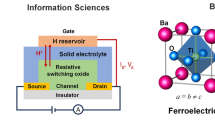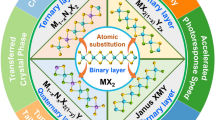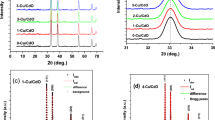Abstract
The emergence of methyl-ammonium lead halide (MAPbX3) perovskites motivates the identification of unique properties giving rise to exceptional bulk transport properties, and identifying future materials with similar properties. Here, we propose that this “defect tolerance” emerges from fundamental electronic-structure properties, including the orbital character of the conduction and valence band extrema, the chargecarrier effective masses, and the static dielectric constant. We use MaterialsProject.org searches and detailed electronic-structure calculations to demonstrate these properties in other materials than MAPbX3. This framework of materials discovery may be applied more broadly, to accelerate discovery of new semiconductors based on emerging understanding of recent successes.





Similar content being viewed by others
References
W. Shockley and H.J. Queisser: Detailed balance limit of efficiency of p–n junction solar cells. J. Appl. Phys. 32, 510–519 (1961). doi:10.1063/1.1736034.
M.B. Prince: Silicon solar energy converters. J. Appl. Phys. 26, 534–540 (1955). doi:10.1063/1.1722034.
L. Yu and A. Zunger: Identification of potential photovoltaic absorbers based on first-principles spectroscopic screening of materials. Phys. Rev. Lett. 108, 068701 (2012). doi:10.1103/PhysRevLett.108.068701.
L. Yu, R.S. Kokenyesi, D.A. Keszler, and A. Zunger: Inverse design of high absorption thin-film photovoltaic materials. Adv. Energy Mater. 3, 43–48 (2013). doi:10.1002/aenm.201200538.
C. Wadia, A.P. Alivisatos, and D.M. Kammen: Materials availability expands the opportunity for large-scale photovoltaics deployment. Environ. Sci. Technol. 43, 2072–2077 (2009). doi:10.1021/es8019534.
D.M. Powell, M.T. Winkler, H.J. Choi, C.B. Simmons, D.B. Needleman, and T. Buonassisi: Crystalline silicon photovoltaics: a cost analysis framework for determining technology pathways to reach baseload electricity costs. Energy Environ. Sci. 5, 5874–5883 (2012). doi:10.1039/ C2EE03489A.
T. Surek: Crystal growth and materials research in photovoltaics: progress and challenges. J. Cryst. Growth 275, 292–304 (2005). doi:10.1016/j.jcrysgro.2004.10.093.
I.L. Repins, H. Moutinho, S.G. Choi, A. Kanevce, D. Kuciauskas, P. Dippo, C.L. Beall, J. Carapella, C. DeHart, B. Huang, and S.H. Wei: Indications of short minority-carrier lifetime in kesterite solar cells. J. Appl. Phys. 114, 084507 (2013). doi:10.1063/1.4819849.
N.M. Mangan, R.E. Brandt, V. Steinmann, R. Jaramillo, J.V. Li, J.R. Poindexter, K. Hartman, L. Sun, R.G. Gordon, and T. Buonassisi: A path to 10% efficiency for tin sulfide devices. In 2014 IEEE 40th Photovoltaic Specialists Conf. PVSC, 2014; 2373–2378. doi:10.1109/ PVSC.2014.6925404.
T. Unold and H.W. Schock: Nonconventional (non-silicon-based) photovoltaic materials. Annu. Rev. Mater. Res. 41, 297–321 (2011). doi:10.1146/annurev-matsci-062910-100437.
S.D. Stranks, G.E. Eperon, G. Grancini, C. Menelaou, M. J.P. Alcocer, T. Leijtens, L.M. Herz, A. Petrozza, and H.J. Snaith: Electron-hole diffusion lengths exceeding 1 micrometer in an organometal trihalide perovskite absorber. Science 342, 341–344 (2013). doi:10.1126/science.1243982.
Q. Dong, Y. Fang, Y. Shao, P. Mulligan, J. Qiu, L. Cao, and J. Huang: Electron–hole diffusion lengths >175 μm in solution grown CH3NH3PbI3 single crystals. Science 347, 967–970 (2015). doi:10.1126/science. aaa5760.
N.J. Jeon, J.H. Noh, W.S. Yang, Y.C. Kim, S. Ryu, J. Seo, and S.I. Seok: Compositional engineering of perovskite materials for high-performance solar cells. Nature 517, 476–480 (2015). doi:10.1038/nature14133.
National Renewable Energy Laboratory. Best research-cell efficiencies. Best Research Cell Efficiency (accessed March 20, 2015). http://www.nrel.gov/ncpv/images/efficiency_chart.jpg
A. Kojima, K. Teshima, Y. Shirai, and T. Miyasaka: Organometal halide perovskites as visible-light sensitizers for photovoltaic cells. J. Am. Chem. Soc. 131, 6050–6051 (2009). doi:10.1021/ja809598r.
M.A. Green, A. Ho-Baillie, and H.J. Snaith: The emergence of perovskite solar cells. Nat. Photonics 8, 506–514 (2014). doi:10.1038/nphoton.2014.134.
C.C. Stoumpos, C.D. Malliakas, and M.G. Kanatzidis: Semiconducting tin and lead iodide perovskites with organic cations: phase transitions, high mobilities, and near-infrared photoluminescent properties. Inorg. Chem. 52, 9019–9038 (2013). doi:10.1021/ic401215x.
J. Mattheis, J. Werner, and U. Rau: Finite mobility effects on the radiative efficiency limit of pn-junction solar cells. Phys. Rev. B 77, 085203 (2008). doi:10.1103/PhysRevB.77.085203.
J.R. Davis, Jr., A. Rohatgi, R.H. Hopkins, P.D. Blais, P. Rai-Choudhury, J.R. McCormick, and H.C. Mollenkopf: Impurities in silicon solar cells. IEEE Trans. Electron Devices 27, 677–687 (1980). doi:10.1109/T-ED.1980.19922.
H.R. Moutinho, R.G. Dhere, M.M. Al-Jassim, C. Ballif, D.H. Levi, A.B. Swartzlander, M.R. Young, and L.L. Kazmerski: Study of CdTe/CdS solar cells using CSS CdTe deposited at low temperature. In 2000 IEEE 28th Photovoltaic Specialists Conf. PVSC, 2000; 646–649.
L. Kranz, C. Gretener, J. Perrenoud, D. Jaeger, S.S.A. Gerstl, R. Schmitt, S. Buecheler, and A.N. Tiwari: Tailoring impurity distribution in polycrystalline CdTe solar cells for enhanced minority carrier lifetime. Adv. Energy Mater. 4, 1301400 (2014). doi:10.1002/aenm.201301400.
I.L. Repins, W.K. Metzger, C.L. Perkins, J.V. Li, and M.A. Contreras: Measured minority-carrier lifetime and CIGS device performance. In 2009 IEEE 34th Photovoltaic Specilists Conf. PVSC, 2009; 000978–000983. doi:10.1109/PVSC.2009.5411126.
O.D. Miller, E. Yablonovitch, and S.R. Kurtz: Strong internal and external luminescence as solar cells approach the Shockley-Queisser limit. IEEE J. Photovolt. 2, 303–311 (2012). doi:10.1109/JPHOTOV. 2012.2198434.
E.A. Schiff: Hole mobilities and the physics of amorphous silicon solar cells. J. Non-Cryst. Solids 352, 1087–1092 (2006). doi:10.1016/j. jnoncrysol.2005.11.074.
W.K. Metzger, D. Albin, D. Levi, P. Sheldon, X. Li, B.M. Keyes, and R.K. Ahrenkiel: Time-resolved photoluminescence studies of CdTe solar cells. J. Appl. Phys. 94, 3549–3555 (2003). doi:10.1063/1.1597974.
D. Walter, F. Rosenits, F. Kopp, S. Reber, B. Berger, and W. Warta: Determining the minority carrier lifetime in epitaxial silicon layers by micro-wave-detected photoconductivity measurements. In 25th Eur. Photovoltaic Solar Energy Conf., Valencia, Spain, 2010; 2078–2083. doi:10.4229/25thEUPVSEC2010-2CV.3.1.
T. Tiedje, C.R. Wronski, B. Abeles, and J.M. Cebulka: Electron transport in hydrogenated amorphous silicon: drift mobility and junction capacitance. Sol. Cells 2, 301–318 (1980). doi:10.1016/0379-6787(80)90034-4.
R.A. Sinton, A. Cuevas, and M. Stuckings: Quasi-steady-state photoconductance, a new method for solar cell material and device characterization. In IEEE 25th Photovoltaic Specialists Conf., Washington, D.C., 1996; 457–460.
J.K. Katahara and H.W. Hillhouse: Quasi-Fermi level splitting and subbandgap absorptivity from semiconductor photoluminescence. J. Appl. Phys. 116, 173504 (2014). doi:10.1063/1.4898346.
A. Jain, S.P. Ong, G. Hautier, W. Chen, W.D. Richards, S. Dacek, S. Cholia, D. Gunter, D. Skinner, G. Ceder, and K.A. Persson: Commentary: the Materials Project: a materials genome approach to acceleratingmaterials innovation. APL Mater. 1, 011002 (2013). doi:10.1063/1.4812323.
W.-J. Yin, T. Shi, and Y. Yan: Unusual defect physics in CH3NH3PbI3 perovskite solar cell absorber. Appl. Phys. Lett. 104, 063903 (2014). doi:10.1063/1.4864778.
W.-J. Yin, T. Shi, and Y. Yan: Unique properties of halide perovskites as possible origins of the superior solar cell performance. Adv. Mater. 26, 4653–4658 (2014). doi:10.1002/adma.201306281.
Y. Yamada, T. Nakamura, M. Endo, A. Wakamiya, and Y. Kanemitsu: Near-band-edge optical responses of solution-processed organicinorganic hybrid perovskite CH3NH3PbI3 on mesoporous TiO2 electrodes. Appl. Phys. Express 7, 032302 (2014). doi:10.7567/APEX.7.032302.
A. Walsh: Principles of chemical bonding and band gap engineering in hybrid organic–inorganic halide perovskites. J. Phys. Chem. C 119, 5755–5760 (2015). doi:10.1021/jp512420b.
M.H. Du: Efficient carrier transport in halide perovskites: theoretical perspectives. J. Mater. Chem. A 2, 9091–9098 (2014). doi:10.1039/ C4TA01198H.
S.B. Zhang, S.-H. Wei, A. Zunger, and H. Katayama-Yoshida: Defect physics of the CuInSe2 chalcopyrite semiconductor. Phys. Rev. B 57, 9642 (1998).
A. Zakutayev, C.M. Caskey, A.N. Fioretti, D.S. Ginley, J. Vidal, V. Stevanović, E. Tea, and S. Lany: Defect tolerant semiconductors for solar energy conversion. J. Phys. Chem. Lett. 5, 1117–1125 (2014). doi:10.1021/jz5001787.
D. Shi, V. Adinolfi, R. Comin, M. Yuan, E. Alarousu, A. Buin, Y. Chen, S. Hoogland, A. Rothenberger, K. Katsiev, Y. Losovyj, X. Zhang, P.A. Dowben, O.F. Mohammed, E.H. Sargent, and O.M. Bakr: Low trap-state density and long carrier diffusion in organolead trihalide perovskite single crystals. Science 347, 519–522 (2015). doi:10.1126/science.aaa2725.
K. Tvingstedt, O. Malinkiewicz, A. Baumann, C. Deibel, H.J. Snaith, V. Dyakonov, and H.J. Bolink: Radiative efficiency of lead iodide based perovskite solar cells. Sci. Rep. 4, 6071 (2014). doi:10.1038/srep06071.
E.M. Miller, Y. Zhao, C.C. Mercado, S.K. Saha, J.M. Luther, K. Zhu, V. Stevanovic, C.L. Perkins, and J. van de Lagemaat: High charge carrier mobilities and lifetimes in organolead trihalide perovskites. Adv. Mater. 26, 1584–1589 (2014). doi:10.1002/adma.201305172.
T. Umebayashi, K. Asai, T. Kondo, and A. Nakao: Electronic structures of lead iodide based low-dimensional crystals. Phys. Rev. B 67, 155405 (2003). doi:10.1103/PhysRevB.67.155405.
E.M. Miller, Y. Zhao, C.C. Mercado, S.K. Saha, J.M. Luther, K. Zhu, V. Stevanović, C.L. Perkins and J. van de Lagemaat: Substrate-controlled band positions in CH3NH3PbI3 perovskite films. Phys. Chem. Chem. Phys. 16, 22122–22130 (2014). doi:10.1039/C4CP03533J.
P. Umari, E. Mosconi, and F. De Angelis: Relativistic solar cells. Sci. Rep. 4, 4467 (2014).
S.M. Sze and K.N. Kwok: Physics of Semiconductor Devices, 3rd ed.; John Wiley & Sons: Hoboken, NJ, 2007.
J.M. Frost, K.T. Butler, F. Brivio, C.H. Hendon, M. van Schilfgaarde, and A. Walsh: Atomistic origins of high-performance in hybrid halide perovskite solar cells. Nano Lett. 14, 2584–2590 (2014).
R.H. Bube: Photoelectronic Properties of Semiconductors (Cambridge University Press: Cambridge, UK, 1992).
Q. Lin, A. Armin, R.C.R. Nagiri, P.L. Burn, and P. Meredith: Electro-optics of perovskite solar cells. Nat. Photonics 9, 106–112 (2015). doi:10.1038/nphoton.2014.284.
E.J. Juarez-Perez, R.S. Sanchez, L. Badia, G. Garcia-Belmonte, Y.S. Kang, I. Mora-Sero, and J. Bisquert: Photoinduced giant dielectric constant in lead halide perovskite solar cells. J. Phys. Chem. Lett. 5, 2390–2394 (2014). doi:10.1021/jz5011169.
F. Brivio, A.B. Walker, and A. Walsh: Structural and electronic properties of hybrid perovskites for high-efficiency thin-film photovoltaics from firstprinciples. APL Mater. 1, 042111 (2013). doi:10.1063/1.4824147.
J. Kim, S.-H. Lee, J.H. Lee, and K.-H. Hong: The role of intrinsic defects in methylammonium lead iodide perovskite. J. Phys. Chem. Lett. 5, 1312–1317 (2014). doi:10.1021/jz500370k.
S.D. Lester, F.A. Ponce, M.G. Craford, and D.A. Steigerwald: High dislocation densities in high efficiency GaN-based light-emitting diodes. Appl. Phys. Lett. 66, 1249 (1995). doi:10.1063/1.113252.
M. Carmody, S. Mallick, J. Margetis, R. Kodama, T. Biegala, D. Xu, P. Bechmann, J.W. Garland, and S. Sivananthan: Single-crystal II–VI on Si single-junction and tandem solar cells. Appl. Phys. Lett. 96, 153502 (2010). doi:10.1063/1.3386529.
Y.S. Lee, M.T. Winkler, S.C. Siah, R. Brandt, and T. Buonassisi: Hall mobility of cuprous oxide thin films deposited by reactive direct-current magnetron sputtering. Appl. Phys. Lett. 98, 192115 (2011). doi:10. 1063/1.3589810.
J.Y.W. Seto: The electrical properties of polycrystalline silicon films. J. Appl. Phys. 46, 5247 (1975). doi:10.1063/1.321593.
J. Yan, P. Gorai, B. Ortiz, S. Miller, S.A. Barnett, T. Mason, V. Stevanović, and E.S. Toberer: Material descriptors for predicting thermoelectric performance. Energy Env. Sci. 8, 983–994 (2014). doi:10.1039/C4EE03157A.
J. Feng: Mechanical properties of hybrid organic–inorganic CH3NH3BX3 (B = Sn, Pb; X = Br, I) perovskites for solar cell absorbers. APL Mater. 2, 081801 (2014). doi:10.1063/1.4885256.
J.J. Krich, B.I. Halperin, and A. Aspuru-Guzik: Nonradiative lifetimes in intermediate band photovoltaics—absence of lifetime recovery. J. Appl. Phys. 112, 013707 (2012). doi:10.1063/1.4732085.
S. DeWolf, J. Holovsky, S.-J. Moon, P. Löper, B. Niesen, M. Ledinsky, F.-J. Haug, J.-H. Yum, and C. Ballif: Organometallic halide perovskites: sharp optical absorption edge and its relation to photovoltaic performance. J. Phys. Chem. Lett. 5, 1035–1039 (2014). doi:10.1021/jz500279b.
P.J. Sellin: Thick film compound semiconductors for X-ray imaging applications. Nucl. Instrum. Methods Phys. Res. A 563, 1–8 (2006). doi:10.1016/j.nima.2006.01.110.
G. Hautier, A. Miglio, G. Ceder, G.-M. Rignanese, and X. Gonze: Identification and design principles of low hole effective mass p-type transparent conducting oxides. Nat. Commun. 4, 2292 (2013). doi: doi:10.1038/ncomms3292.
R. Nechache, C. Harnagea, S. Licoccia, E. Traversa, A. Ruediger, A. Pignolet, and F. Rosei: Photovoltaic properties of Bi2FeCrO6 epitaxial thin films. Appl. Phys. Lett. 98, 202902 (2011). doi:10.1063/1.3590270.
J. Rödel, W. Jo, K.T.P. Seifert, E.-M. Anton, T. Granzow, and D. Damjanovic: Perspective on the development of lead-free piezoceramics. J. Am. Ceram. Soc. 92, 1153–1177 (2009). doi:10.1111/j.1551-2916.2009.03061.x.
A.-V. Mudring: Thallium halides–new aspects of the stereochemical activity of electron lone pairs of heavier main-group elements. Eur. J. Inorg. Chem. 2007, 882–890 (2007). doi:10.1002/ejic.200600975.
M.-H. Du and D.J. Singh: Enhanced born charge and proximity to ferroelectricity in thallium halides. Phys. Rev. B 81, 144114 (2010).
M.-H. Du and D.J. Singh: Enhanced born charges in III-VII, IV-VII2, and V-VII3 compounds. Phys. Rev. 82, 045203 (2010). doi:10.1103/PhysRevB.82.045203.
S.P. Ong, W.D. Richards, A. Jain, G. Hautier, M. Kocher, S. Cholia, D. Gunter, V.L. Chevrier, K.A. Persson, and G. Ceder: Python materials Genomics (pymatgen): a robust, open-source python library for materials analysis. Comput. Mater. Sci. 68, 314–319 (2013). doi:10.1016/j.commatsci.2012.10.028.
A. Walsh, D.J. Payne, R.G. Egdell, and G.W. Watson: Stereochemistry of post-transition metal oxides: revision of the classical lone pair model. Chem. Soc. Rev. 40, 4455 (2011). doi:10.1039/c1cs15098g.
V. Stevanović, K. Hartman, R. Jaramillo, S. Ramanathan, T. Buonassisi, and P. Graf: Variations of ionization potential and electron affinity as a function of surface orientation: the case of orthorhombic SnS. Appl. Phys. Lett. 104, 211603 (2014). doi:10.1063/1.4879558.
I. Chung, J.-H. Song, J. Im, J. Androulakis, C.D. Malliakas, H. Li, A.J. Freeman, J.T. Kenney, and M.G. Kanatzidis: CsSnI3: semiconductor or metal? High electrical conductivity and strong near-infrared photoluminescence from a single material. High hole mobility and phase-transitions. J. Am. Chem. Soc. 134, 8579–8587 (2012). doi:10.1021/ja301539s.
R. Nechache, C. Harnagea, S. Li, L. Cardenas, W. Huang, J. Chakrabartty, and F. Rosei: Bandgap tuning of multiferroic oxide solar cells. Nat. Photonic. 9, 61–67 (2015). doi:10.1038/nphoton.2014.255.
A.T. Lintereur, W. Qiu, J.C. Nino, and J. Baciak: Characterization of bismuth tri-iodide single crystals for wide band-gap semiconductor radiation detectors. Nucl. Instrum. Methods Phys. Res. 652, 166–169 (2011). doi:10.1016/j.nima.2010.12.013.
J. Vidal, S. Lany, J. Francis, R. Kokenyesi, and J. Tate: Structural and electronic modification of photovoltaic SnS by alloying. J. Appl. Phys. 115, 113507 (2014). doi:10.1063/1.4868974.
E.A. Secco and A. Sharma: Structure stabilization: locking-in fast cation conductivity phase in TlI. J. Phys. Chem. Solid. 56, 251–254 (1995). doi:10.1016/0022-3697(94)00172-3.
R. Nitsche and W.J. Merz: Photoconduction in ternary V-VI-VII compounds. J. Phys. Chem. Solids 13, 154–155 (1960).
N.T. Hahn, A.J.E. Rettie, S.K. Beal, R.R. Fullon, and C.B. Mullins: n-BiSI thin films: selenium doping and solar cell behavior. J. Phys. Chem. 116, 24878–24886 (2012). doi:10.1021/jp3088397.
N.T. Hahn, J.L. Self, and C.B. Mullins: BiSI micro-rod thin films: efficient solar absorber electrodes? J. Phys. Chem. Lett. 3, 1571–1576 (2012). doi:10.1021/jz300515p.
X. Zhang, L. Zhang, T. Xie, and D. Wang: Low-temperature synthesis and high visible-light-induced photocatalytic activity of BiOI/TiO2 heterostructures. J. Phys. Chem. 113, 7371–7378 (2009). doi:10.1021/jp900812d.
K. Zhao, X. Zhang, and L. Zhang: The first BiOI-based solar cells. Electrochem. Commun. 11, 612–615 (2009). doi:10.1016/j.elecom.2008.12.041.
K.T. Butler, J.M. Frost, and A. Walsh: Ferroelectric materials for solar energy conversion: photoferroics revisited. Energy Environ. Sci. 8, 838–848 (2015). doi:10.1039/C4EE03523B.
B.V. Gabrel’yan, A.A. Lavrentiev, I.Y. Nikiforov, and V.V. Sobolev: Electronic energy structure of MBiS2 (M = Li, Na, K) calculated with allowance for the difference between the M-S and Bi-S bond lengths. J. Struct. Chem. 49, 788–794 (2008). doi:10.1007/s10947-008-0140-2.
S. Kang, Y. Hong, Y. Jeon, and A. Facile: Synthesis and characterization of sodium bismuth sulfide (NaBiS2) under hydrothermal condition. Bull. Korean Chem. Soc. 35, 1887–1890 (2014). doi:10.5012/bkcs.2014.35.6.1887.
T.J. McCarthy, S.P. Ngeyi, J.H. Liao, D.C. DeGroot, T. Hogan, C.R. Kannewurf, and M.G. Kanatzidis: Molten salt synthesis and properties of three new solid-state ternary bismuth chalcogenides, beta.-CsBiS2, gamma.-CsBiS2, and K2Bi8Se13. Chem. Mater. 5, 331–340 (1993). doi:10.1021/cm00027a016.
T. Timofte and A.-V. Mudring: Indium(I) Tetraiodoaluminate. Z. Anorg. Allg. Chem. 634, 622–623 (2008). doi:10.1002/zaac.200700525.
S.V. Mel’nikova and A.I. Zaitsev: Ferroelectric phase transition in Cs3Bi2I9. Phys. Solid State 39, 1652–1654 (1997).
E.Y. Peresh, V.I. Sidei, N.I. Gaborets, O.V. Zubaka, I.P. Stercho, and I.E. Barchii: Influence of the average atomic number of the A2TeC6 and A3B2C9 (A = K, Rb, Cs, Tl(I); B = Sb, Bi; C = Br, I) compounds on theirmelting point and band gap. Inorg. Mater. 50, 101–106 (2014). doi:10.1134/S0020168514010166.
R. Jakubas and L. Sobczyk: Phase transitions in alkylammonium halogenoantimonates and bismuthates. Phase Transit. 20, 163–193 (1990). doi:10.1080/01411599008206873.
L.-M. Wu, X.-T. Wu, and L. Chen: Structural overview and structure–property relationships of iodoplumbate and iodobismuthate. Coord. Chem. Rev. 253, 2787–2804 (2009). doi:10.1016/j.ccr.2009.08.003.
T. Plackowski, D. Wlosewicz, P.E. Tomaszewski, J. Baran, and M.K. Marchewka: Specific heat of (NH2(CH3)2)3Bi2I9. Acta Phys. Pol. A 87, 635–641 (1995).
G. Kieslich, S. Sun, and A.K. Cheetham: Solid-state principles applied to organic–inorganic perovskites: new tricks for an old dog. Chem. Sci. 5, 4712–4715 (2014). doi:10.1039/C4SC02211D.
M.R. Filip, G.E. Eperon, H.J. Snaith, and F. Giustino: Steric engineering of metal-halide perovskites with tunable optical band gaps. Nat. Commun. 5, 5757 (2014). doi:10.1038/ncomms6757.
G. Kresse and J. Furthmüller: Efficient iterative schemes for ab initio totalenergy calculations using a plane-wave basis set. Phys. Rev. 54, 11169–11186 (1996). doi:10.1103/PhysRevB.54.11169.
J.P. Perdew, K. Burke, and M. Ernzerhof: Generalized gradient approximation made simple. Phys. Rev. Lett. 77, 3865–3868 (1996). doi:10.1103/ PhysRevLett.77.3865.
P.E. Blöchl: Projector augmented-wave method. Phys. Rev. 50, 17953–17979 (1994). doi:10.1103/PhysRevB.50.17953.
V. Stevanović, S. Lany, X. Zhang, and A. Zunger: Correcting density functional theory for accurate predictions of compound enthalpies of formation: fitted elemental-phase reference energies. Phys. Rev. 85, 115104 (2012). doi:10.1103/PhysRevB.85.115104.
X. Wu, D. Vanderbilt, and D.R. Hamann: Systematic treatment of displacements, strains, and electric fields in density-functional perturbation theory. Phys. Rev. 72, 035105 (2005). doi:10.1103/PhysRevB.72.035105.
Acknowledgments
This work was supported as part of the Center for Next Generation Materials by Design (CMGMD), an Energy Frontier Research Center funded by the U.S. Department of Energy, Office of Science, Basic Energy Sciences. R.E.B. acknowledges an NSF GRFP fellowship. The authors thank R. Jaramillo, R. Chakraborty, V. Steinmann, and R. Kurchin (MIT) as well as S. Lany and A. Zakutayev (NREL) for helpful conversations.
Author information
Authors and Affiliations
Corresponding authors
Rights and permissions
About this article
Cite this article
Brandt, R.E., Stevanović, V., Ginley, D.S. et al. Identifying defect-tolerant semiconductors with high minority-carrier lifetimes: beyond hybrid lead halide perovskites. MRS Communications 5, 265–275 (2015). https://doi.org/10.1557/mrc.2015.26
Received:
Accepted:
Published:
Issue Date:
DOI: https://doi.org/10.1557/mrc.2015.26




